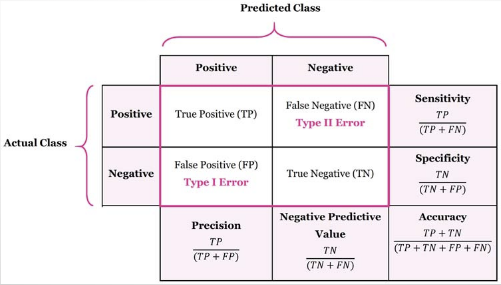Note
0.0(0)
Explore Top Notes Note
Note Studied by 60 people
Studied by 60 people Note
Note Studied by 11 people
Studied by 11 people Note
Note Studied by 8 people
Studied by 8 people Note
Note Studied by 28 people
Studied by 28 people Note
Note Studied by 32 people
Studied by 32 people Note
Note Studied by 18 people
Studied by 18 people
Quadratic Graphs
4.2(5)
Digital Communication in Health Care
5.0(1)
House + Home
5.0(1)
What is Bioethics? + History of Bioethics, Normative Ethics, and Principlism
5.0(2)
Ch 30 - Barriers to Development
5.0(1)
Iliaca interna o hiposgástrica
5.0(1)
Logistic Regression
ASSESSING LOGISTIC REGRESSION MODELS \n (CONFUSION MATRIX)
- ACCURACY
- (TRUE POSITIVES AND NEGATIVES) / (TOTAL CASES)
- TP + TN / (TP + TN + FP + FN)
- ERROR RATE
- (FALSE POSITIVES AND NEGATIVES) / (TOTAL CASES)
- FP + TN /(TP+TN+FP+FN)
- SENSITIVITY (RECALL)
- (TRUE POSITIVES) / (TOTAL ACTUAL POSITIVES)
- TP /(TP + FN)
- POSITIVE PREDICTIVE VALUE (PRECISION)
- (TRUE POSITIVES) / (TOTAL PREDICTED POSITIVES)
- TP/(TP+FP)
- SPECIFICITY
- (TRUE NEGATIVES) / (TOTAL ACTUAL NEGATIVES)
- TN / (TN+FP)

Regression
- Regression Analysis - Helps one understand how the typical value of the dependent variable changes when any one of the independent variables is varied, while the other independent variables are held fixed.
- What is the focus of regression - The focus is on the relationship between a dependent variable (i.e., Response, outcome, target) and one or more independent variables (or 'predictors‘, ‘features’).
- What is understood better with regression - Helps one understand how the typical value of the dependent variable changes when any one of the independent variables is varied, while the other independent variables are held fixed.
Supervised Machine Learning Method w/ Logistic Regression
- Logistic Regression is used to predict the categorical dependent variable using a given set of independent variables.
- What type of problems is Logistic Regression used for to solve?
- Classification
- What do we predict in Logistic Regression?
- The values of categorical variables
- By finding the S-curve what are we able to accomplish?
- Classifying the samples
- What must the output be for Logistic Regression?
- Categorical variable(ex: 0 or 1, Yes or No, etc.)
- What is not required of Logistic Regression?
- It is not required to have the linear relationship between the dependent and independent variables.
\
Note
0.0(0)
Explore Top Notes Note
Note Studied by 60 people
Studied by 60 people Note
Note Studied by 11 people
Studied by 11 people Note
Note Studied by 8 people
Studied by 8 people Note
Note Studied by 28 people
Studied by 28 people Note
Note Studied by 32 people
Studied by 32 people Note
Note Studied by 18 people
Studied by 18 people
Quadratic Graphs
4.2(5)
Digital Communication in Health Care
5.0(1)
House + Home
5.0(1)
What is Bioethics? + History of Bioethics, Normative Ethics, and Principlism
5.0(2)
Ch 30 - Barriers to Development
5.0(1)
Iliaca interna o hiposgástrica
5.0(1)